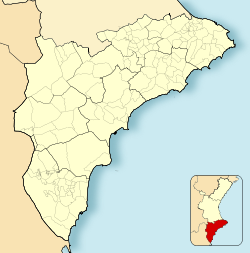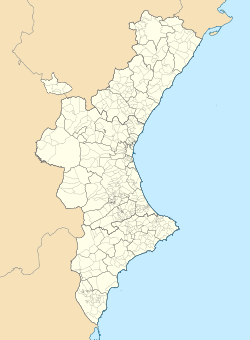|
Callosa de Segura
Callosa de Segura (Spanish pronunciation: [kaˈʎosa ðe seˈɣuɾa]) is a municipality in the comarca of Vega Baja del Segura in the Valencian Community, Spain. It contains the historic monument of the Church of St Martin. Callosa de Segura is a traditional Spanish-speaking town located north-west of Orihuela. It can be reached via the A-7 (E15) motorway, junction 79, or from the AP-7 motorway, junction 733 and is situated just 30 minutes from Alicante and Murcia airports and 30 minutes from Guardamar beach. The town is dominated by the Sierra de Callosa mountains standing behind it, and some of the houses of the town creep up the side of the mountain together with various crops high up on terraced slopes. Main sights The Saint Roque Hermitage stands high above the town as if guarding it; above the hermitage is the castle of Callosa. The hermitage was built in 1579–1798 in honour of the patron saint of Callosa de Segura - Saint Roque, it is said that Saint Roque appeared on the spot where the hermitage is built. The Saint Martin's Church, dating from the 16th - 18th centuries, has a blue decorated dome. The chapel of the church contains some pieces of gold work by Miguel de Vera. The old part of the town, just below the hermitage, has very narrow streets. The original town slaughterhouse built in 1929 is now renovated and houses a history museum of the town. The museum has four sections:
EconomyThe economy of the town is dependent mostly on agriculture and manufacturing; hemp based cordage products being an important part of this. References
|
||||||||||||||||||||||||||||||||||||||||||||||||||




